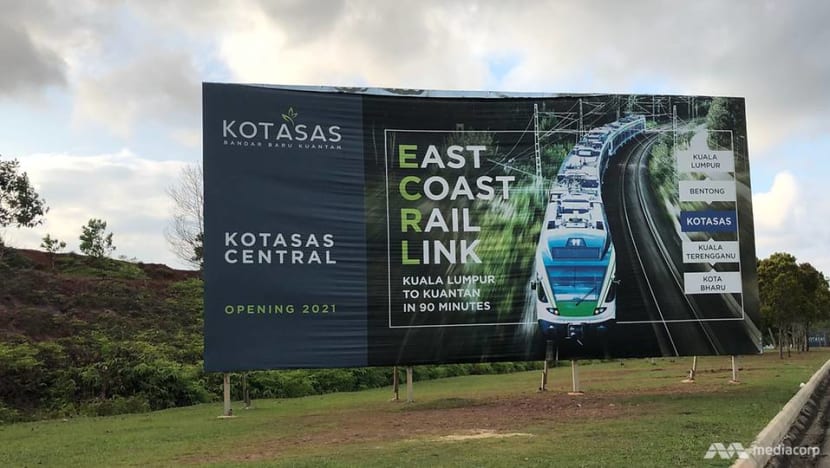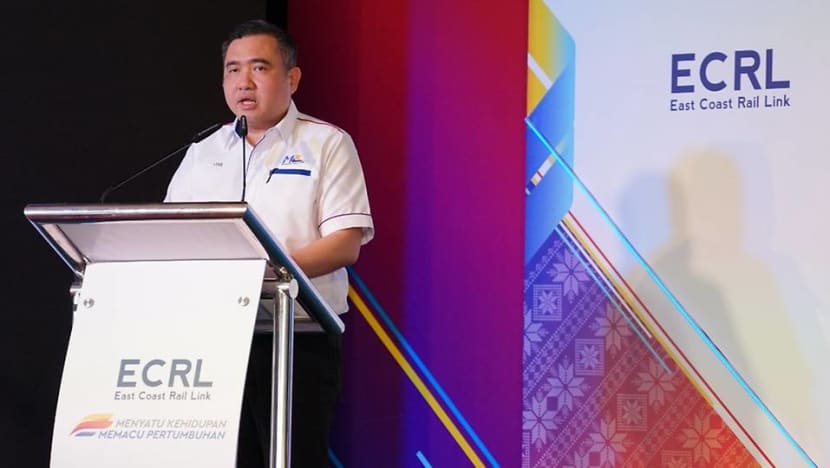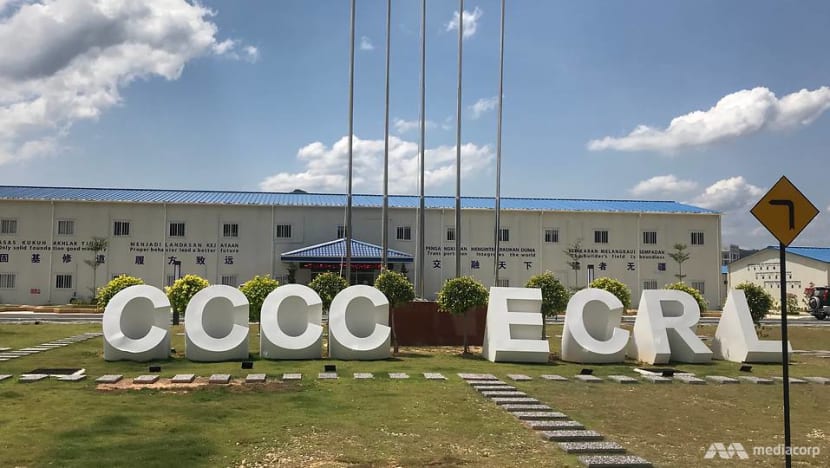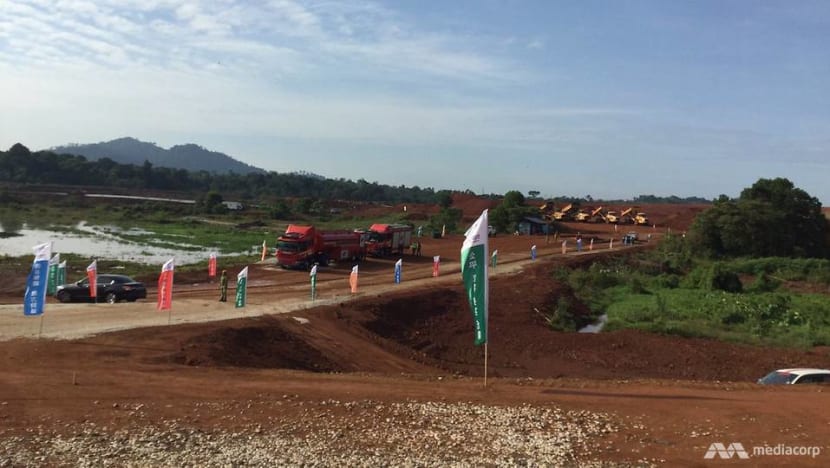commentary Commentary
Commentary: Malaysia’s East Coast Rail Link alignment is anything but settled
Economic gains have been highlighted but political considerations may have also contributed to the East Coast Rail Link re-routing, says ISEAS - Yusof Ishak Institute’s Kevin Zhang.

View of an East Coast Rail Link billboard. (Photo: Norbakti Alias)
SINGAPORE: Plans for Malaysian’s East Coast Rail Link (ECRL) have changed yet again.
An ambitious rail project intended to spur economic development along states hugging the east coast by connecting them to the prosperous Klang Valley, the project was put on the backburner by the Pakatan Harapan (PH) coalition, which swept into power in 2018, only to be revived in 2019 after a massive cost-cutting exercise.
This time, the change involved the section of the line running between Port Klang in Selangor and Temerloh in Pahang.
Malaysian Transport Minister Dr Wee Ka Siong announced last Monday (Apr 5), the ECRL will revert to a northern alignment.
READ: Commentary: The impasse over the East Coast Rail Link is hurting Malaysia’s credibility
READ: Commentary: Johor city dwellers hit hard by MCO but rural communities fare worse
BOTH THE SOUTHERN AND NORTHERN ALIGNMENT HAVE POLITICAL CONSIDERATIONS
Perhaps not coincidentally, both stations in Negeri Sembilan under the earlier southern alignment – Klawang and Nilai – were in state constituencies won by PH won in GE2018.
Under initial plans announced by the Barisan Nasional (BN) government in 2017, the railway was supposed to traverse central Selangor before entering Pahang in Bentong.
However, in 2019, after some dancing around whether the ECRL would be canned, the PH government announced changes to the project that could shave off RM21.5 billion (US$5.2 billion) from its original price tag of RM 65.5 billion.
READ: Commentary: Did the KL-Singapore high-speed rail unravel because of costs? Note other railways in Asia
The plan was to reroute the rail line southwards through Negeri Sembilan before heading north to Port Klang while skipping Bentong and central Selangor.
This southern alignment was touted by then Transport Minister Anthony Loke as a game-changer that could serve as an economic catalyst for Negeri Sembilan, which was excluded from the original northern route.

Notably, Mr Loke himself is MP for Seremban, a constituency in Negeri Sembilan.
The economic synergy in connecting Port Klang to other parts of Malaysia should not be underestimated. The proposed ECRL terminal at Port Klang under the southern alignment would be sited at Westports which is adjacent to Carey Island, an area earmarked for the expansion of shipping facilities at Port Klang.
But observers have highlighted the northern alignment would also generate significant economic spill-over effects, proposed by the then BN government in 2017. Freight usage and passenger ridership for ECRL would be higher with a northern alignment, which cuts through more developed and densely populated areas in Selangor.
This is also the option the current Perikatan Nasional (PN) government is now putting forth. It will come with greater costs, as the line cuts through the Titiwangsa Mountains requiring more bridges and tunnels to be constructed.
The announced revised cost for this new ECRL route is RM6 billion more than the southern alignment at a cost of RM50 billion (inclusive of the Serendah rail bypass).
(Listen to Malaysians share their very different experiences of living through the pandemic in Johor, Kuala Lumpur and Sabah on CNA's Heart of the Matter podcast:)
WHAT’S BEHIND PUTTING BENTONG AND GOMBAK BACK ON THE ECRL
Political considerations may have contributed to the changes in Malaysia’s positions and repeated realignments for ECRL.
With the Perikatan Nasional (PN) in power since last year’s Sheraton move, it is perhaps not so coincidental that the routing has changed yet again.
Under the new alignment, Bentong in Pahang and Gombak in Selangor will be added to the route with stations constructed in both locations.

Bentong has typically elected a BN candidate as its Member of Parliament (MP) – under the component party Malaysian Chinese Association (MCA) – until GE2018 where then MCA chairman Liow Tiong Lai lost it by a narrow margin despite being the incumbent for four terms.
BN is presently the coalition with the largest share of MPs within the PN coalition, and MCA-BN is likely interested in wrestling the seat back from PH in the upcoming general election.
It’s no wonder Dr Wee, who is also President of the MCA, supports the move for a northern alignment.
READ: Commentary: A change of heart? Under Mahathir, Malaysia makes bold move to embrace China
Gombak station falls within the Gombak constituency helmed by Azmin Ali from Parti Pribumi Bersatu Malaysia (Bersatu).
Azmin is an important PN leader serving as both senior Minister and Minister for Trade and Industry.
Large-scale infrastructure projects, like the ECRL, will allow BN and Bersatu to score brownie points with the electorate during the next GE.
Such developments can spur economic growth within localities through which the line passes through.

Interestingly, Negeri Sembilan, a PH governed state, will be excluded from the new ECRL alignment.
SELANGOR MAY BE A SPOILER
It comes as little surprise also the Selangor state government, in response to the ECRL alignment, has publicly stated it prefers the southern alignment, citing higher economic benefits and fewer socio-environmental costs.
The Selangor state government under PH could be spoiler in these plans.
Land acquisition along the northern alignment has not started as the new alignment was announced only recently.
As land matters under the Malaysian constitution comes under the purview of the state governments rather than the federal government, cooperation from the Selangor state government will be critical to the construction of the ECRL.
READ: Commentary: Connecting Singapore and Malaysia without an HSR challenging but alternatives should be explored
Should the Selangor state government choose not to collaborate with the Transport Ministry to acquire land along the northern alignment, the ECRL is likely to face further delays and may miss the 2027 deadline to begin operations.
In addition, given that snap elections remain a real possibility once the State of Emergency ends in August 2021, further changes to the ECRL should not be excluded.
Kevin Zhang is a Research Officer with the Malaysia Studies Programme at the ISEAS - Yusof Ishak Institute.















